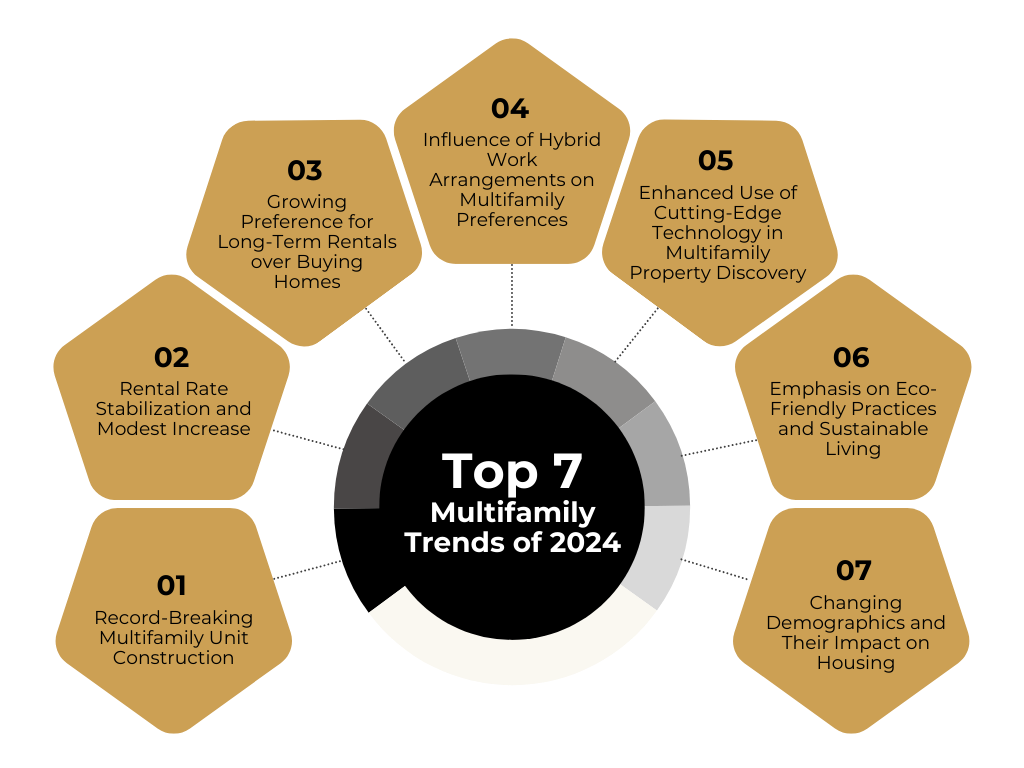Top 7 Multifamily Trends of 2024
|
FEBRUARY 28, 2024
|
Introduction:
Looking forward to 2024, the landscape of multifamily real estate is alive with transformation and potential. I’m excited to share with you the seven leading trends that are revolutionizing our sector. Whether you’re fully immersed or just beginning to explore passive investments, these critical insights will help you maintain a competitive edge.

1. Record-Breaking Multifamily Unit Construction
The year 2024 is poised to set a new record in the construction of multifamily units, heralding an unprecedented increase in housing availability. This surge is the result of a robust lineup of projects that began in earlier years. However, a decline in the initiation of new construction projects, driven by economic factors like changes in interest rates, indicates that this peak may be fleeting. The consequences of this deceleration are expected to become more apparent in 2025. Nonetheless, for 2024, the market will witness intensified competition due to the significant entry of new properties.
2. Rental Rate Stabilization and Modest Increase
Following a period of significant fluctuations, the multifamily rental market is anticipated to stabilize in 2024, with rental rates forecasted to grow steadily but modestly. This trend is supported by a stable employment landscape, ongoing demand for housing, and current economic uncertainties. The expected single-digit growth in rental prices signifies the market’s adjustment towards balance after recent upheavals.
3. Growing Preference for Long-Term Rentals over Buying Homes
The multifamily market is witnessing a significant trend: a growing inclination towards long-term rentals rather than pursuing homeownership. This shift is fueled by elevated mortgage rates and the challenging affordability of the home purchase market for many people. As a result, the demographic composition of renters is evolving, with an increasing number of individuals, even those who typically prefer to buy, choosing longer rental commitments. This trend offers real estate operators and investors new opportunities to serve the expanding pool of long-term renters by providing customized services and amenities.
4. Influence of Hybrid Work Arrangements on Multifamily Preferences
The rise of hybrid work arrangements is significantly altering preferences in multifamily real estate. As more people work remotely or in hybrid settings, there’s a growing need for residences that support home office setups. This shift is also affecting where people choose to live, with a noticeable trend towards multifamily locations farther from conventional business districts. This change offers real estate developers a chance to rethink property designs and amenities to meet the demands of a workforce that places a high value on flexibility and convenience.
5. Enhanced Use of Cutting-Edge Technology in Multifamily Property Discovery
In 2024, the use of sophisticated technologies, particularly artificial intelligence (AI), is predicted to accelerate in the search for multifamily properties. Leveraging the technological progress made in recent years, AI is expected to become increasingly influential in guiding potential renters and buyers through the property market. This encompasses the use of AI-enhanced search functionalities, immersive virtual tours, and customized property suggestions. The integration of these technological solutions aims to refine the property discovery process, providing improved efficiency and a customized experience for users.
6. Emphasis on Eco-Friendly Practices and Sustainable Living
The growing concern for environmental sustainability is influencing the multifamily real estate sector significantly. As environmental awareness rises among consumers, there’s a heightened demand for green housing solutions. This encompasses buildings that optimize energy use, utilize sustainable building materials, and incorporate features aimed at minimizing environmental impact. Real estate developers committed to eco-friendly construction methods and sustainable practices are expected to appeal to an expanding portion of the market.
7. Changing Demographics and Their Impact on Housing
Shifts in demographics, including the aging of populations in some areas and the emergence of millennials and Generation Z as significant groups of homebuyers and renters, are reshaping housing demands and preferences. These changes are encouraging real estate developers and managers to offer a wider variety of housing solutions, such as homes suitable for multiple generations, cost-effective options for young adults, and accommodations with features designed for older individuals.
Conclusion
As we prepare for 2024, the multifamily real estate sector is flourishing, brimming with fresh opportunities. For investors such as yourself, this period represents an exhilarating phase to engage with the market’s transformation. Whether you’re aiming for a deeper involvement or simply wish to stay updated, these trends serve as your guide to navigating the multifamily domain with wisdom and insight. Let’s look forward to a year filled with growth, innovation, and prosperous investments!
Remember, be bold, achieve greatness, and continue to advance!
Explore Opportunities with Faris Capital Partners. Are you an accredited investor looking to delve into passive investments in multifamily properties? Click here to arrange a discussion with our Investor Relations team and learn more.
Interested in learning more about Multifamily Apartment Investing? Download our FREE E-book – The Full Out Apartment Investor
Ready to connect?
Book a call with our investor relations team today to learn more about current investment opportunities.
Have a question?
Please use the form below to contact us. We will never spam you, or sell your email to third parties.



